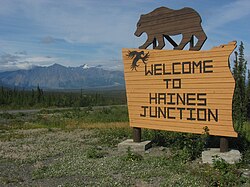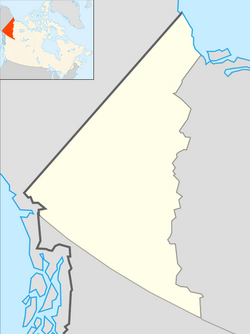Haines Junction, Yukon
Haines Junction | |
|---|---|
| Village of Haines Junction | |
 | |
| Coordinates: 60°45′10″N 137°30′24″W / 60.75278°N 137.50667°W | |
| Country | Canada |
| Territory | Yukon |
| Founded | 1942 |
| Incorporated | 1984 |
| Government | |
| • Village Mayor | Michael Riseborough |
| • Governing body | Village of Haines Junction Council |
| Area | |
| • Land | 34.49 km2 (13.32 sq mi) |
| Population (2016) | |
| • Total | 613 |
| • Density | 17.8/km2 (46/sq mi) |
| • Change 2011-2016 | |
| Time zone | UTC−08:00 (PST) |
| • Summer (DST) | UTC−07:00 (PDT) |
| Postal code | |
| Area code | +1-867 |
| Climate | Dsc |
| Website | www.hainesjunctionyukon.com |
Haines Junction is a village in Yukon, Canada. It is located at Kilometre 1,632 (historical mile 1016) of the Alaska Highway at its junction with the Haines Highway, hence the name of the community. According to the 2016 Census, the population was 613.[2] Haines Junction is east of Kluane National Park and Reserve. It is a major administrative centre for the Champagne and Aishihik First Nations.
History
For around two thousand years, the Southern Tutchone people had seasonal hunting and fishing camps in the area of present-day Haines Junction. The original name of the area was "Dakwakada", a Southern Tutchone word meaning "high cache". It was common for Tutchone people to use raised log caches to store food year-round or temporarily while they hunted and fished in an area.
The Haines Junction area was also important for trade between the coastal and interior peoples. It lies at the interior end of the Chilkat Pass, one of only three passes that allowed travel between the coast and the interior, which was used extensively for trade between the coastal Tlingit and Southern Tutchone people.
The current town of Haines Junction was established in 1942 and 1943 during the construction of the Alaska Highway. In 1943, a second highway, the Haines Highway, was built to connect the Alaska Highway with the coastal town of Haines, Alaska, over the Chilkat Pass. Situated at the junction of these two highways, Haines Junction was a construction camp and a supply and service centre for the U.S. Army Corps of Engineers building the highway. The 626-mile (1,007 km) Haines–Fairbanks petroleum pipeline was constructed in 1953–55, and a pumping station was built just north of Haines Junction.[3]
Demographics
Transportation

By road, Haines Junction is served by the Alaska Highway and the Haines Highway (Yukon Highway 3). By air, it is served by the Haines Junction Airport.
Climate
Haines Junction has a subarctic climate (Dfc) with mild summers and long, severely cold and snowy winters, with annual snowfall averaging 64.5 inches (164 cm).
| Climate data for Haines Junction | |||||||||||||
|---|---|---|---|---|---|---|---|---|---|---|---|---|---|
| Month | Jan | Feb | Mar | Apr | May | Jun | Jul | Aug | Sep | Oct | Nov | Dec | Year |
| Record high °C (°F) | 7.0 (44.6) |
13.0 (55.4) |
14.0 (57.2) |
21.0 (69.8) |
27.0 (80.6) |
33.0 (91.4) |
30.5 (86.9) |
31.0 (87.8) |
23.0 (73.4) |
22.0 (71.6) |
12.0 (53.6) |
14.5 (58.1) |
33.0 (91.4) |
| Mean daily maximum °C (°F) | −15.3 (4.5) |
−8.1 (17.4) |
−0.1 (31.8) |
8.4 (47.1) |
— | — | 19.1 (66.4) |
17.1 (62.8) |
14.0 (57.2) |
4.8 (40.6) |
−8.3 (17.1) |
−10.9 (12.4) |
2.1 (35.8) |
| Daily mean °C (°F) | −20.6 (−5.1) |
−15.0 (5.0) |
−7.8 (18.0) |
0.9 (33.6) |
— | — | 12.5 (54.5) |
10.6 (51.1) |
7.2 (45.0) |
−1.0 (30.2) |
−13.2 (8.2) |
−15.9 (3.4) |
−4.2 (24.4) |
| Mean daily minimum °C (°F) | −25.9 (−14.6) |
−21.1 (−6.0) |
−15.2 (4.6) |
−6.5 (20.3) |
— | — | 5.9 (42.6) |
4.0 (39.2) |
0.4 (32.7) |
−6.7 (19.9) |
−17.4 (0.7) |
−20.5 (−4.9) |
−10.3 (13.5) |
| Record low °C (°F) | −48.0 (−54.4) |
−47.5 (−53.5) |
−42.0 (−43.6) |
−32.0 (−25.6) |
−11.0 (12.2) |
−3.5 (25.7) |
−1.5 (29.3) |
−4.0 (24.8) |
−11.0 (12.2) |
−27.0 (−16.6) |
−42.0 (−43.6) |
−44.5 (−48.1) |
−48.0 (−54.4) |
| Average precipitation mm (inches) | 33.8 (1.33) |
24.5 (0.96) |
12.5 (0.49) |
7.9 (0.31) |
18.0 (0.71) |
35.3 (1.39) |
45.5 (1.79) |
37.7 (1.48) |
35.0 (1.38) |
26.7 (1.05) |
36.3 (1.43) |
40.1 (1.58) |
353.2 (13.91) |
| Average rainfall mm (inches) | 0.3 (0.01) |
0.5 (0.02) |
0.3 (0.01) |
2.2 (0.09) |
15.8 (0.62) |
35.3 (1.39) |
45.5 (1.79) |
37.7 (1.48) |
33.1 (1.30) |
11.2 (0.44) |
2.7 (0.11) |
4.9 (0.19) |
189.3 (7.45) |
| Average snowfall cm (inches) | 33.6 (13.2) |
24.0 (9.4) |
12.2 (4.8) |
5.7 (2.2) |
2.2 (0.9) |
0.0 (0.0) |
0.0 (0.0) |
0.0 (0.0) |
1.9 (0.7) |
15.5 (6.1) |
33.6 (13.2) |
35.3 (13.9) |
163.9 (64.5) |
| Average precipitation days (≥ 0.2 mm) | 8.4 | 5.6 | 3.5 | 2.7 | 5.5 | 7.8 | 8.4 | 8.5 | 8.7 | 7.0 | 8.4 | 8.3 | 82.7 |
| Average rainy days (≥ 0.2 mm) | 0.1 | 0.2 | 0.1 | 0.8 | 5.2 | 7.8 | 8.4 | 8.5 | 8.3 | 3.1 | 0.3 | 0.4 | 43.1 |
| Average snowy days (≥ 0.2 cm) | 8.4 | 5.4 | 3.5 | 2.0 | 0.4 | 0.0 | 0.0 | 0.0 | 0.5 | 3.8 | 8.2 | 8.0 | 40.2 |
| Source: Environment Canada Canadian Climate Normals 1981–2010[6] | |||||||||||||
See also
References
- ^ Your Elected Officials
- ^ Population and dwelling counts Statistics Canada
- ^ http://www.arlis.org/docs/vol1/AlaskaGas/Report4/Report_CEMML_2003_HainesFairbanksPipeline.pdf
- ^ "2006 Community Profiles". 2006 Canadian Census. Statistics Canada. August 20, 2019.
- ^ "2001 Community Profiles". 2001 Canadian Census. Statistics Canada. July 18, 2021.
- ^ "Haines Junction YTG" (CSV (2874 KB)). Canadian Climate Normals 1981–2010. Environment Canada. Climate ID: 2100631. Retrieved 2014-02-20.[permanent dead link]


